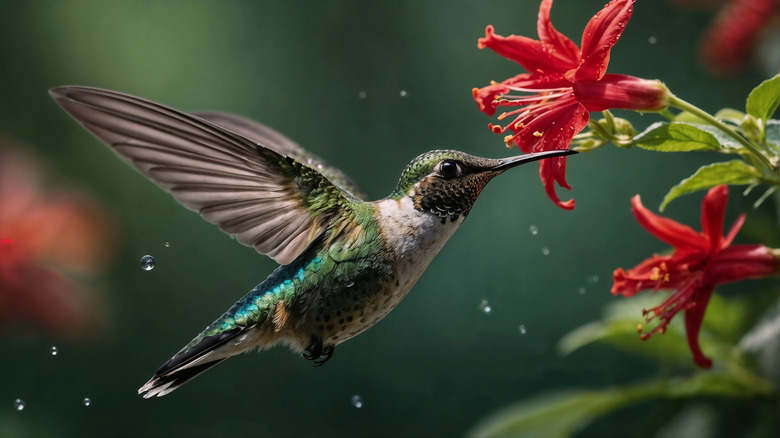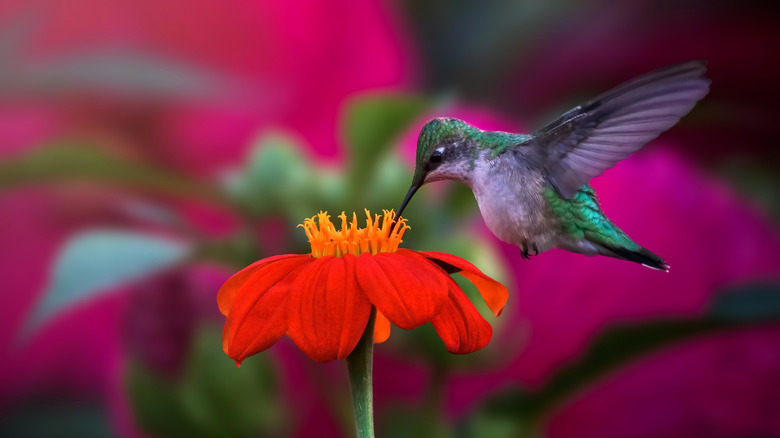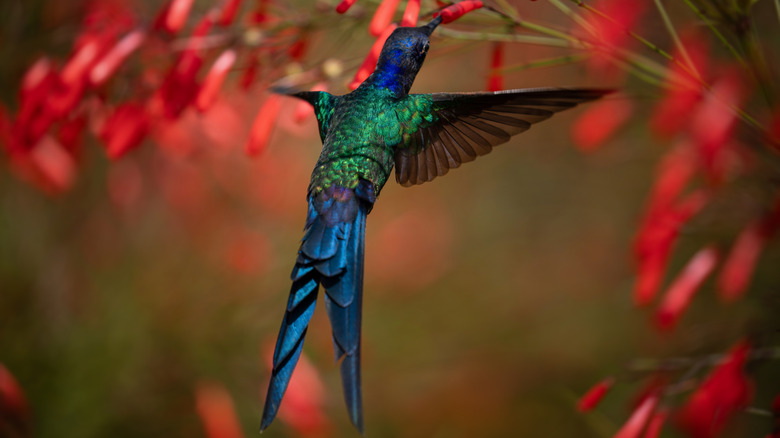The Truth Behind Why Hummingbirds Seem To Be Attracted To The Color Red
Hummingbirds are remarkable for many reasons. Hummingbirds are the only bird that can fly backwards with wings that beat 60 to 80 times per second, which works out to around 720 to 5,400 times per minute while hovering. In order to maintain that kind of physical exertion, however, hummingbirds need a lot of food to provide the energy they need. As such, a big part of the bird's diet is mostly made up of nectar that's high in sugar, though they also supplement that sugar intake with insects.
When seeking out this sustenance, hummingbirds often seem to be drawn to the color red. The red bird of paradise (Caesalpinia pulcherrima), for instance, is known to attract them, but what is it about red that seems to reliably draw them in? Is it just a bright, attractive color, or is there more to the story? Well, as it turns out, the evidence for hummingbirds being attracted to red isn't actually all that clear, and there's a lot we don't know about color preference among these fascinating birds.
In a 2012 study published in Plant Species Biology, authors Corinne Handelman and Joshua R. Kohn note how hummingbird flowers are typically red, but that there is a lack of research to explain why that might be the case. As such, the duo observed hummingbird behavior in relation to flower color of Mimulus aurantiacus which has blossoms that range from yellow to red. They found that hummingbirds visited the two yellowest color classes the least and actually visited orange flowers most. The authors also noted that while the birds preferred flowers with red pigments, the reddest flowers weren't the most attractive. Making things more complicated was the fact that the studies reviewed by the researchers did show a consistent preference for red among hummingbirds when it came to flowers.
In other words, the preference for red among hummingbirds is not a clearly understood phenomenon, but research backs up the claim that hummingbirds prefer red over other colors when it comes to flowers. As for why, there are a few theories.
Other pollinators may be responsible for hummingbird's red preference
We do know that birds have excellent color vision, so it seems as though color would play a role in which flowers hummingbirds choose to visit. But rather than being an inherent preference for a particular hue, it could be that hummingbirds have evolved a tendency to visit whatever color represents the nectar-producing flowers of their habitat or whichever flowers will provide them with the most nectar. In many natural habitats, those flowers happen to be red, and there is research which suggests this is all down to other pollinators' habits.
In a 2017 study published in PLOS One, researchers discussed the existing literature and noted that hummingbirds' previous experience of colors has been shown to be an integral part of their color choice when it comes to artificial feeders. Hummingbirds found near red flowers, such as red-flowered Ribes speciosm plants, were shown to choose red feeders, while those captured near yellow-flowered Nicotiana glauca preferred yellow feeders. The birds could also be trained to prefer certain colors when they got more nectar out of particular feeders, suggesting that reward, and not color, is the most important factor.
Still, experts mostly agree that plants visited by hummingbirds predominantly have red flowers. A 2011 study in the Journal of Experimental Biology notes that this fact has been known "for decades" but that the research was fairly slim and that plants with white flowers are also commonly visited by the creatures. The researchers carried out preference tests using artificial flowers to try to provide their own insights and their findings suggested that hummingbird preference may in part be due to bees, which were shown to prefer red UV-reflecting artificial flowers and white UV-nonreflecting flowers over red and white flowers with the opposite UV properties. Essentially, then, bees weren't attracted to red flowers and as such, the researchers argued, hummingbirds might simply be capitalizing on a niche provided by the bees' preferences rather than solely following their own color preferences.
Plants may have played a role in hummingbird color preference
Studies that have tested hummingbird preferences haven't established an innate bias towards red, which further points towards other mechanisms that contribute to their apparent preference for the color. Interestingly enough, rather than bees simply preferring certain colors, it seems plants may well have played a role in determining hummingbird preferences, too. That is to say, there are plenty of studies which suggest flowers have actually evolved to deter bees in order to attract other pollinators, including hummingbirds, which are less likely than bees to eat the pollen itself,making them more attractive pollinators for the plants as they will spread more pollen rather than eating it. This theory suggests that flowers have evolved to be red in order to dissuade bees from visiting them, leaving a niche for hummingbirds to exploit.
A 2017 study in the journal Evolutionary Ecology, showed that bees found it harder to identify red flowers in more complex environments where there was green foliage present, which supports the hypothesis that plants evolved a red color to deter bees in favor of bird pollination. In this view, hummingbirds visit red more frequently because bees are less likely to do so, and so may have evolved their apparent "preference" for red simply as a result of flowers evolving to deter bees and attract birds.
While research is ongoing, then, it seems hummingbirds' apparent proclivity for pollinating red flowers boils down to a complex mix of factors that involves flower evolution, bee preference, and hummingbirds' own experience with particular colors.


